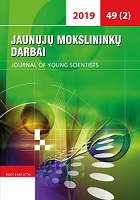ISLAMOFOBIJA, MUSULMONŲ REPREZENTACIJA IR STEREOTIPAI VAKARUOSE PO 9/11 ĮVYKIŲ
ISLAMOPHOBIA, MUSLIM REPRESENTATION AND STEREOTYPES IN THE WESTERN MEDIA AFTER THE 9/11 EVENTS
Author(s): Rūta SutkutėSubject(s): Media studies, Islam studies, Social psychology and group interaction, Radical sociology , Sociology of Politics, Peace and Conflict Studies
Published by: Vilniaus Universiteto Leidykla
Keywords: media; stereotypes; Muslim representation; Islamophobia; Muhammad cartoons; Orientalism;
Summary/Abstract: The role of the media as an intermediary between the formation of images and the representation of reality in the context of Orientalism and Islamophobia was analyzed in the paper. In the 21st century the media has become the dominant source of knowledge about Islam and the Muslims because it selectively decides what the West should know about Islam and what should be disguised. However, the underlying assumption is media, as a stereotype formation institution, opportunities depend on a local sociocultural context. The main goal of this research was to identify the role of the media as an intermediary in shaping social values and worldviews and stereotyping in different cultural environments on the basis of the Muhammad caricature crisis analysis. In order to achieve this objective the following tasks were set: to analyze the role of the media as an intermediary in shaping value-based orientation and constructing stereotypes, to clarify the concepts of a stereotype and Islamophobia and to identify a link between a negative image of Islam and the Muslims constructed by the media, to examine media constructed stereotypes of the Muslims and Islam in four different countries on the basis of the Muhammad caricature case. Quantitative content analysis was carried out and the hypothesis that the same event is differently portrayed in different cultures seeking to shape value orientation of a specific audience it is targeting at was proved. The Western media seeks to portray the Muslims as terrorists / Islamists who oppose the West, its values and any possibility of integration in a Western society. Meanwhile, in the Lebanon and India (Kashmir) media, there is no manifestation of Orientalism and Islamophobia because the audience it is targeting at is dominated by the Muslims; however, there is a noticeable manifestation of Occidentalism - resistance to the West and portrayal of Western societies as Islamophobic. Comparative analysis confirmed the statement that actors with very different believes and values construct different stories of an event. The Western media mainly publishes statements of those politicians, writers and journalists, who promote the phenomena of Muslim marginalization, stigmatization and Islamophobia. Meanwhile, in a cardinally opposite culture (Kashmir and Lebanon), the actors, Muslim representatives, religious leaders (imams), who are in power to form value orientation and public opinion and whose statements are reproduced in articles, express a hostile position to the West and its hegemony in the Orient.
Journal: Jaunųjų mokslininkų darbai
- Issue Year: 2019
- Issue No: 2 (49)
- Page Range: 36-49
- Page Count: 14
- Language: Lithuanian

